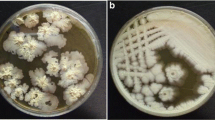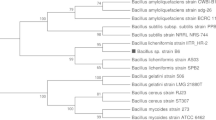Abstract
A total of 29 strains of Brucella abortus, B. melitensis, B. suis, B. ovis, and B. neotomae were examined for growth and catechol production in a semisynthetic low-iron medium. All strains showed reduced growth yields and, quantitatively, production of catechols varied widely among the different strains with no relationship to species, biotypes, or serotypes of Brucella. No clear correlation between catechol production and growth under iron-limiting conditions was observed. The major catechol was identified as 2,3-dihydroxybenzoic acid, and neither other iron-regulated catechols nor hydroxamate type compounds were detected when representative strains of B. abortus or B. melitensis were grown in tryptic soy broth in the presence of iron-sequestering agents.
Similar content being viewed by others
Literature Cited
Arnow LE (1937) Colorimetric determination of the compounds of 3,4-dihydroxyphenylalanine-tyrosine mixture. J Biol Chem 118:531–537
Baldwin CL, Jiang X, Fernandes DM (1993) Macrophages control of Brucella abortus: influence of cytokines and iron. Trends Microbiol 1:99–104
Corbel MJ (1989) Microbiology of the genus Brucella. In: Young EJ, Corbel MJ (eds) Brucellosis: clinical and laboratory aspects. Boca Raton, Fl.: CRC Press, pp 53–72
Feistner GJ, Beaman BL (1987) Characterization of 2,3-dihydroxybenzoic acid from Nocardia asteroides GUH-2. J Bacteriol 169:3982–3987
González-Carreró M, Mellado MA, Agüero J (1993) Asimilación de hierro por Brucella abortus: caracterización fenotípica de mutantes. XIV Congreso Nacional de Microbiología 8–11 September 1993 at Zaragoza, Spain. Abstr: CP08-2-12
Griffiths E (1987) The iron-uptake systems for pathogenic bacteria. In: Bullen JJ, Griffiths E (eds) Iron and infection. New York: John Wiley & Sons, Ltd., pp 69–137
Hantke K (1990) Dihydroxybenzoylserine: a siderophore for Escherichia coli. FEMS Microbiol Lett 67:5–8
López-Goñi I, Moriyón I, Neilands JB (1992) Identification of 2,3-dihydroxybenzoic acid as a Brucella abortus siderophore. Infect Immun 60:4496–4503
Neilands JB (1981) Iron absorption and transport in microorganisms. Annu Rev Nutr 1:27–46
O'Brien IG, Cox GB, Gibson F (1970) Biologically active compounds containing 2,3-dihydroxybenzoic acid and serine formed by Escherichia coli. Biochim Biophys Acta 201:453–460
Persmark M, Expert D, Neilands JB (1992) Ferric iron uptake in Erwinia chrysanthemi mediated by chrysobactin and related catechol-type compounds. J Bacteriol 174:4783–4789
Rogers HJ, Synge C, Kimber B, Bayley PM (1977) Production of enterochelin by Escherichia coli 0111. Biochim Biophys Acta 497:548–557
Smith AW, Freeman S, Minett WG, Lambert PA (1990) Characterization of a siderophore from Acinetobacter calcoaceticus. FEMS Microbiol Lett 70:29–32
Verger JM, Grimont F, Grimont PAD, Grayon M (1985) Brucella, a monospecific genus as shown by deoxyribonucleic acid hybridization. Int J Syst Bacteriol 35:292–295
Yancey RJ, Finkelstein RA (1981) Siderophore production by pathogenic Neisseria spp. Infect Immun 32:600–608
Author information
Authors and Affiliations
Rights and permissions
About this article
Cite this article
López-Goñi, I., Moriyón, I. Production of 2,3-dihydroxybenzoic acid by Brucella species. Current Microbiology 31, 291–293 (1995). https://doi.org/10.1007/BF00314582
Issue Date:
DOI: https://doi.org/10.1007/BF00314582




